With the metal roof now secure on the new porch on our Casa and Office, the Gila Nature Blog can resume once more. Frequently Becky’s “little” home improvement projects can become rather all-consuming, and the Porch Project was no exception. But now that the result has passed muster by The Boss (and I’m quite pleased with it myself), it’s a real treat to get back to the computer and writing.
In my June 24 blog entry, Waiting for the Rains Time, the forecast was for a 10% probability of rain for the coming week. Sure enough, on July 1st we had .04 inches of rain! The drought of the past five months had been broken. By the middle of July two more light rains had produced another 0.2 inches for us here at Casitas de Gila Guesthouses, but areas close by were receiving rains of up to an inch or more. Though very spotty in distribution at first, the rains continued to increase both in frequency and amount, so that by the end of July the Casitas had received slightly over two inches for the month.
The reason for the slow start of the monsoon season for New Mexico has been nicely documented in the Southwest Monsoon Tracker, a blog put out by the University of Arizona. Essentially, the cause of the late start is due to the fact that the high pressure systems which are essential to the start of the heavier rains of the Monsoon Season and which are normally located over the Four-Corners area of New Mexico/Arizona/Utah/Colorado, where they draw up moisture from the Gulf of Mexico, were initially located too far to the east over New Mexico. Hence, the winds have predominantly come from the east instead of from the south resulting in fewer favorable days for widespread thunderstorm activity.
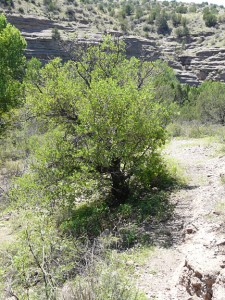
During the first two weeks of August, however, the location of the high pressure systems normalized somewhat and moved further west, resulting in heavier and more frequent rains moving into western New Mexico. Such has been the case here at Casitas de Gila Guesthouses, where as of this date 6.06 inches of rain have fallen during the first two weeks of this month, with one impressive thunderstorm dropping 3.46 inches in a bit over an hour, causing some washouts on our road and requiring immediate remediation on my part with our trusty Kubota tractor.
With the rain, the landscape around Casitas de Gila has turned from a drab brown to a bright green once more! It’s been fascinating to watch this extremely rapid change. With the soil now saturated with water, the rate of germination and growth is phenomenal. The Desert Scrub Oak (Quercus turbinella), mostly bare of leaves just two weeks ago, now sport a luxurious crown of bright green new leaves. The Sideoats Grama (Bouteloua curtipendula) and Blue Grama (Bouteloua gracilis), the dominant grasses here at the Casitas and dormant since last September, have now come back to life with great passion, once more turning the hillsides from brown to green, much to the epicurean delight and satisfaction of our two horses, Saino and Yaqui!
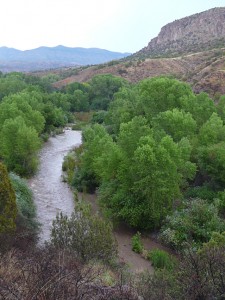
So far for this Monsoon Season, Bear Creek has flooded three times. Although short lived, the first flash flood on July 24 was most impressive, causing the creek to cover the entire floodplain to a depth of four feet or so of rushing water. Choked with branches, dead tree trunks, and organic debris from last winter’s accumulation, this first flood took out some fences in the horses’ corral. Not a major concern, though, as it happens every year; we’ll put them back in September once the rains are over. Within two or three hours after the first flood, Bear Creek was back to a trickle as the water table within the floodplain had not risen significantly.
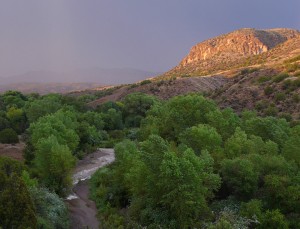
All of this changed on August 9, when the second flash flood took place as a result of the 3.43-inch deluge. This time, however, the flood lasted well into the next day, closing State Highway 211 in Gila for the first time this year for several hours. As of today, the Creek below the Casitas is still running full in its channel and will probably stay that way for the rest of the year, since the groundwater table of the floodplain is now nearly back up to its normal level.
With the restoration of normal water levels in Bear Creek, the plethora of animal life commented on in my last blog of June 24 has disappeared, the animals having once again dispersed into the surrounding hills and mountains as a result of the annual filling and freshening of stock tanks and numerous small springs. They will gradually return, however, once they have had a chance to explore the greened-up hills, valleys, and mountains bordering Bear Creek.
Even though the three floods in the past three weeks have been small to moderate in magnitude and duration, a walk along the creek yesterday by Becky, our neighbor Bill, and myself and our dogs revealed rather amazing changes in the stream bed topography and deposits. Once again one is reminded of how sporadic geologic change in the desert really is: months and months of suspended geologic process with no visible change in the landscape, followed by extreme energy expenditure and major modification within just a few hours. Nowhere was the affect of the 3.43-inch cloudburst of July 9 more evident than the Dry Wash Trail on the south end of the Casita de Gila Nature Preserve. This trail follows the bed of a short, dry wash canyon extending from the uppermost slopes of South Peak across from the Casitas, westward to the Bear Creek floodplain. With a drop of about 800 vertical feet in 0.6 mile, the drainage cuts across volcanic rhyolite, ash-fall tuffs, and pyroclastic breccias before crossing a vertical fault about halfway down the mountain. It then becomes deeply incised in the sedimentary Gila Conglomerate, an interesting formation of this area containing a rich and highly diverse assemblage of volcanic and sedimentary pebbles, cobbles, and boulders up to a foot or more in diameter. A hike up the Dry Wash Trail presents an interesting journey back through geologic time, and is a favorite destination for rockhounds staying at Casitas de Gila because of the variety of rocks and minerals that can be found there.
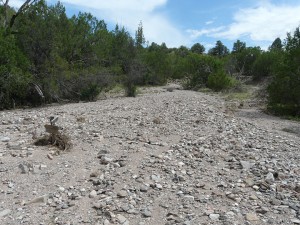
On this day, however, the once-so-familiar Dry Wash Trail was virtually unrecognizable. At the beginning of the trail where the canyon empties onto the Bear Creek floodplain, we found the marker signpost for the trail buried some two feet deep in newly deposited, coarse, gravelly outwash covering a vast area estimated at some 600-800 tons. That’s a lot of earth material to be transported in less than an hour’s time!
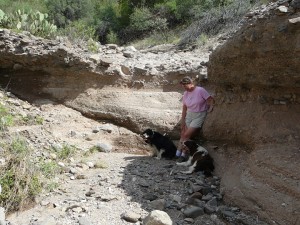
As we slowly made our way up the canyon, we soon found ourselves in what seemed to be a totally new canyon, one in which all the familiar spots along the trail had been completely obliterated, either deeply scoured away or covered up by the tons upon tons of sand to huge boulder-sized rocks that had crashed down through the chasm in a maelstrom of churning water, sand and rock. What a treasure trove of new rocks and minerals to hunt through and collect
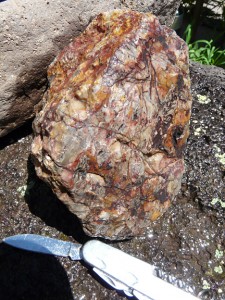
Jaded as we are by collecting on our property for the last 12-plus years, Becky insisted on me carrying home a good-sized chunk of beautiful multi-colored jasper breccia. (Actually, I would have carried it home anyway; it was too nice to leave behind!)
For the curious naturalist, the Monsoon Season is an exceptionally interesting period in Southwest New Mexico — so much can happen in so short a time. And each year is different, depending on the overall weather patterns. Generally, the season lasts until the middle of September. This year, 2011, has been a year of unusual and exceptional weather events all around the globe. It will be most interesting to see how the rest of the Monsoon Season plays out in Southwest New Mexico.


